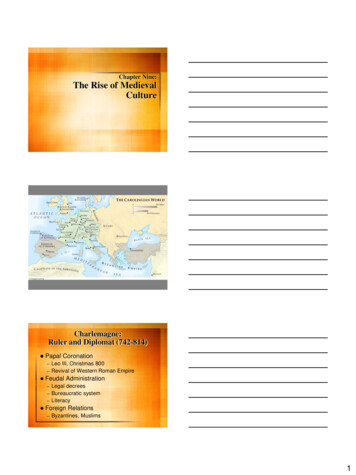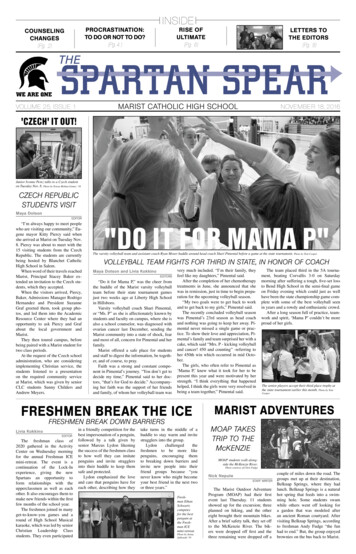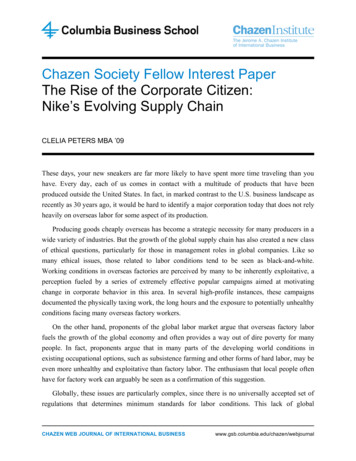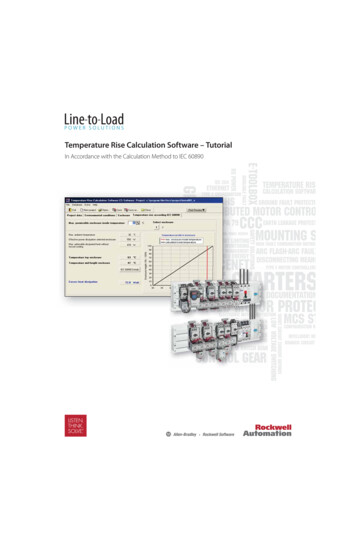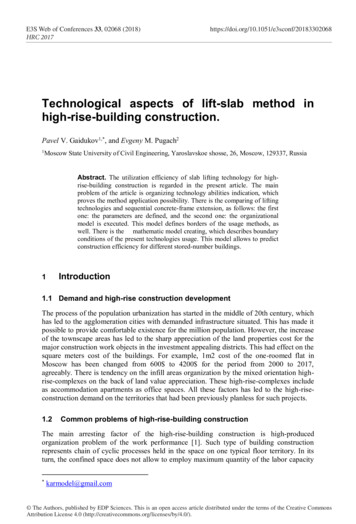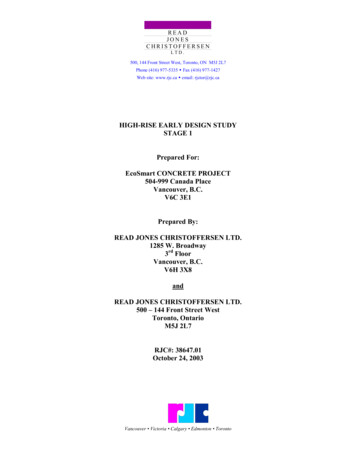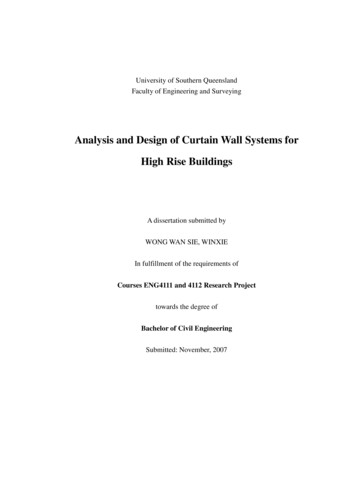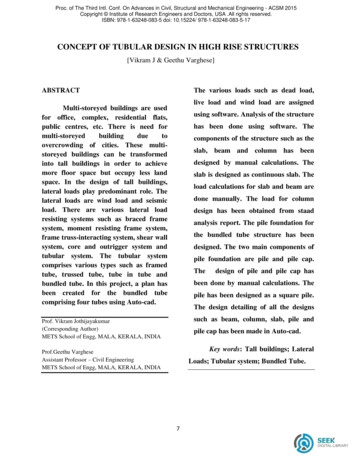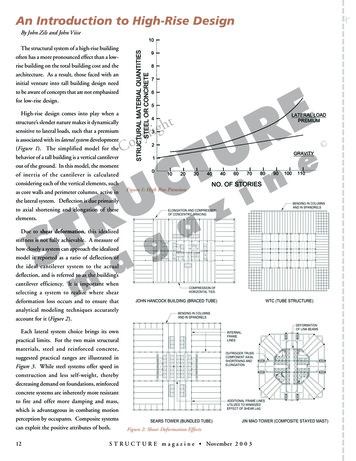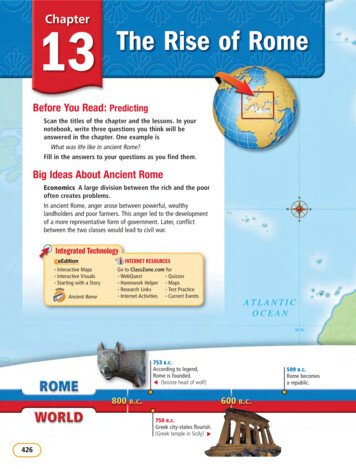
Transcription
Chapter13The Rise of RomeBefore You Read: PredictingScan the titles of the chapter and the lessons. In yournotebook, write three questions you think will beanswered in the chapter. One example isWhat was life like in ancient Rome?Fill in the answers to your questions as you find them.Big Ideas About Ancient RomeEconomics A large division between the rich and the pooroften creates problems.In ancient Rome, anger arose between powerful, wealthylandholders and poor farmers. This anger led to the developmentof a more representative form of government. Later, conflictbetween the two classes would lead to civil war.NEWSIntegrated TechnologyINTERNET RESOURCESInteractive MapsInteractive Visuals Starting with a Story Ancient RomeGo to ClassZone.com for WebQuest Quizzes Homework Helper Maps Research Links Test Practice Internet Activities Current EventsATLANTICOCEAN20 W 753 B.C .According to legend,Rome is founded.(bronze head of wolf) 750 B.C .Greek city-states flourish.(Greek temple in Sicily)426509 B.C .Rome becomesa republic.
The Roman Empire at Its Height, A.D. 11760 erR.RomeBlack SeaITALTHRACEByzantiumY40 NGREECESardiniaBalearicIslandsANATOLIATigr isRive ean ARABIAEGYPT500 miles500 kilometersleReNiRoman Republic, 264 B.C.d27 B.C .Augustus becomes the firstemperor of Rome.(cameo of young Augustus)321 B.C .Maurya empire isfounded in India.117Rome reaches itsgreatest extent.A . D.30Jesus is crucified.A . D.100Moche culture arisesin South America. 202 B.C .Liu Bang reunifies China andstarts the Han Dynasty.(clay horse from the Han Dynasty)Tropic of Cancer40 EA . D. 146 B.C .Rome defeats Carthagein the Punic Wars.a20 ESe0 Ri v e rAreas added at empire's height, A.D. 117427
Background: In 49 B.C., Julius Caesar became the soleruler of Rome. At first, Caesar was a popular and effectiveleader. But in time, the Senate, Rome’s governing body,resented his power. On March 15, 44 B.C., some of thesenators took action.The Senate held a meeting on that fateful day. Thesenators entered one by one and, finally, Caesar came intothe chamber. And then an incredible scene unfolded. Bust of Julius Caesar428
Starting with a Storyaesar took his seat in the center of the chamber. According tocustom, he was the only one allowed to sit. Before Caesar calledthe meeting to order, the senators talked in small groups. Then one of themen stepped forward to ask Caesar a question. He even grabbed Caesar’sshoulder. Angrily, the ruler waved him away, but the senator seemeddetermined to gain his attention.While Caesar argued with his questioner, another senator movedforward. Silently, he drew out a knife and wounded the ruler with hisweapon. Caesar cried out in surprise and rose from his chair. He pulledout a knife from the folds of his toga and defended himself. The senatorstumbled backward, but the others moved forward. They all drew out theirknives. It was a plot!Caesar made no sound as the senators attacked him. He pulled thehood of his toga over his head and adjusted the garment over his feet. Ashe fell to the ground, the toga covered his body. When the senators finallystepped back, Caesar was dead.One of the senators ordered a pair of servants to remove the body. Thepeople of Rome would soon learn that their ruler had been killed. Noone—not even the senators—knew what would happen to Rome next.What might drive people to overthrowtheir leader?1. READING: Setting Setting is when and where a storytakes place. How does this story’s setting help the senatorscarry out their plot?2. WRITING: Persuasion The date is March 14, 44 B.C.You are a Roman senator who opposes the plot againstCaesar. Write a speech in which you explain and supportyour position for letting Caesar continue his rule.429
Lesson1MAIN IDEASCulture Stories about the beginnings of Romeare a mix of legend and historical fact.Geography The people who settled Romechose a geographic location that was good fordefense, travel, and trade.Economics To survive, Roman farmers reliedon discipline and hard work.TAKING NOTESReading Skill: CategorizingSorting similar kinds of information into groups helpsyou understand patterns in history. As you readLesson 1, look for details about the three categoriesgiven for ancient Rome. Record the information youlearn about them in a web diagram like the one below.BeginningsGeography Symbol of Rome Thisstatue of the goddess Romarepresents ancient Rome.Romans believed that thegoddess protected them andtheir city.Ancient RomeEarly RomansSkillbuilder Handbook, page R6Words to KnowUnderstanding the following words will help you read this lesson:descendant a personrelated to a particularparent, grandparent, orother ancestor (page 432)Descendants of a Trojanwarrior may have foundedRome.430 Chapter 13abandon to leavebehind, to desert(page 432)At an early age, thetwins were abandonedby their mother.vast very great in areaor size (page 432)The vast Roman Empirewould stretch from Britainto Egypt.fetch to go after andreturn with; to get(page 435)The farmer asked hisdaughter to fetch a bucket ofwater from a nearby stream.
TERMS & NAMESThe Geographyof Ancient RomeRomuluslegendAeneasRemusrepublicpeninsulaBuild on What You Know You have probably seenmovies about ancient Rome, with its Colosseum andgladiators. These films show Rome at its height, but theyonly tell part of the story. The founding of the civilizationowes much to its geography.The Beginnings of RomeESSENTIAL QUESTION What is the early history of Rome?The history of ancient Rome begins with the overthrow offoreign kings in 509 B.C. But Romans like to date the historyof their city to 753 B.C. That is when a legendary hero calledRomulus (RAHM yuh luhs) is said to have founded Rome.A legend is a popular story from earlier times that cannotbe proved. The legend about Rome’s founding begins withAeneas (ih NEE uhs), a hero of the Trojan War. You learnedabout the Trojan War in Chapter 11. According to thelegend, Aeneas settled in Italy after Troy was destroyed.Palatine Hill Tracesof settlements datingfrom around 1000 B.C.have been found onthe Palatine Hill. 431
The Founding of Rome The legend continues with the twinsRomulus and Remus (REE muhs), the descendants of Aeneasaccording to some versions. They were abandoned by their motherbut rescued by a wolf. When the twins grew up, they decidedto found a city but fought over its location. Romulus killed hisbrother and traced Rome’s boundaries around the Palatine Hill.After Romulus, a series of Roman kings ruled the city.Sometime in the 600s B.C., however, the Etruscans conqueredRome. The Etruscans were a people from northern Italy. Butthe Romans wanted self-rule. In 509 B.C., they overthrew theEtruscan king and formed a republic. A republic is a governmentin which people elect their leaders. You will learn about theRoman Republic in Lesson 2.Why are the dates 753 B.C. and 509 B.C. important?Rome’s Geographic LocationESSENTIAL QUESTION Why wasRome’s location so favorable?Seven Hills of Rome,0about A.D. 1250.5.51 mile1 kilometerSeAfter the overthrow of theEtruscans, Rome grew from a cityinto a country and then into avast empire. Its location helpedmake this growth possible.rviaillHlalHillminnaViiuiral lQrRiverCaHi pi tolll inbe432 Chapter 13PantheonTipeople founded Rome, not figuresfrom legend. The first settlersof Rome were the Latins. Theycame from a region surroundingRome. They chose the spot for itsmild climate, good farmland, andstrategic location.The Latins and later settlers builtRome on seven steep hills. (See mapat right.) During the day, settlersfarmed the fertile plain at the baseof the hills. At night, they returnedto their hilltop homes, from whichthey could defend themselvesagainst an enemy attack.nWHills and River In reality,eEsquilineHillPalatineHillRoman ForumM Cirax cuim sAventine usHillNEWColosseumCaelianHillAppiaGEOGRAPHY SKILLBUILDERINTERPRETING MAPSHuman-Environment InteractionWhat human-made structures helpedprotect Rome from invasion?nWayS
The Tiber RiverDuring Rome’s earliest times, theTiber provided a source of waterfor farming and drinking. Later, theriver provided a route for traveland trade. Small ships could sail upthe Tiber to Rome and down theTiber to the Mediterranean. But theriver also offered protection frominvaders, since Rome was locatedaway from the mouth of the sea.GEOGRAPHY SKILLBUILDERINTERPRETING VISUALSHuman-Environment InteractionWhat does the photograph suggestabout the importance of the Tiber toRomans today?Rome had other advantages. It was located a short distance fromthe Mediterranean Sea on several ancient trade routes. It also lay nextto the Tiber River. As you learned in the Geography feature above,this river played an important role in Rome’s development.Italian Peninsula Rome’s location on the Italian Peninsula alsoplayed an important role in its development. The peninsula stretchessouth from Europe into the Mediterranean Sea. A peninsula is a pieceof land surrounded on three sides by water. As you can see on themap on page 427, the Italian Peninsula is shaped like a boot. Its heelpoints toward Greece, while its toe points across the sea to Africa.Italy’s location on the Mediterranean made it relatively easy forRoman ships to reach the other lands around the sea. This positionmade it easier for Rome to eventually conquer and gain newterritories. It also helped the development of trade routes.The two main mountain ranges of Italy helped protect Rome. TheAlps border Italy on the north, and the Apennines (AP uh NYNZ)form Italy’s spine. But Italy’s mountains didn’t separate earlysettlements the way the mountains of Greece did. Italy also had morelarge plains than Greece. This made farming easier.How did its geography help Rome grow?The Rise of Rome 433
Lives of Early RomansESSENTIAL QUESTION What was life like for the early Romans?Like many ancient peoples, the early Romans lived by farming.But even though the land was fertile, life on a Roman farm wasnot easy.Working the Land Most early Romans worked small plotsof land. They planted grains such as wheat and barley. Theyalso grew beans, vegetables, and fruit. Later they learned togrow olives and grapes. They also raised pigs, sheep, goats, andchickens. They used oxen to pull their plows.Farmers who owned land also served in the army. In fact, fora time only landowners were allowed to join the army. Romanleaders believed that property owners would fight harder todefend the city. Landowners were also able to pay for their ownmilitary equipment.Over time, some farmers grew richer than others. Theybought more land and built larger farms, or estates. A gapConnect to Todaydeveloped between small farmers and the owners of theItalian Farm Grapes,estates. This gap would later produce divisions in Romanlike these shown here,politics and government.are still a popular cropFarm Life At first, most Roman farmers lived in simplehomes made of mud or timber. They did not have muchfurniture. In addition, the farmers lived in extended families.This large family group might have included grandparents,aunts and uncles, nieces and nephews, and cousins.434 Chapter 13in Italy. In ancientRome, only wealthyfarmers, who couldafford to wait a fewyears to harvestthe first crop, grewgrapes.
The members of a Roman farm family had to work very hard.They farmed the land with simple tools and fetched water from awell or nearby spring. The small amount of land on most farmshad to produce enough food to feed the family. This meant thateveryone had to be disciplined about his or her responsibilities.The qualities of discipline, loyalty, and hard work that theseearly farmers developed would help Rome succeed. They werethe qualities that made Roman armies so successful. Whensoldiers went to war, they had to obey orders and do their jobs.This attitude would help Rome conquer all of Italy.Why was discipline important to early Romans?Lesson Summary Legend and fact shaped Rome’s early history. Rome’s geography encouraged the growth ofRoman civilization. Roman society benefited from the hard work anddiscipline of Roman farmers.Why It Matters Now . . .There are still many cultural connections among Mediterraneanareas of Europe, Asia, and Africa as a result of Rome’s influence.1Homework HelperClassZone.comTerms & Names1. Explain the importance ofRomulusAeneasrepubliclegendRemuspeninsulaUsing Your NotesCategorizing Use your web diagram to answer thefollowing question:2. Which category of information would you use todescribe why Rome developed into a powerfulcivilization?BeginningsGeographyMain Ideas3. What is the legend of Rome’s founding?4. How was Rome’s location good for defense?5. Why did early Romans have to work hard?Critical Thinking6. Making Inferences What does the legendabout Rome’s founding tell you about what wasimportant to Romans?7. Comparing and Contrasting Compare the roleof the Tiber in the development of ancient Romewith that of the Nile in ancient Egypt.Ancient RomeEarly RomansIllustrating a Legend Draw a picture that illustrates a scene from the legendaryfounding of Rome.The Rise of Rome 435
Lesson2MAIN IDEASEconomics Early Roman society was dividedinto two unequal classes.Government The Roman Republic had agovernment divided into three parts, similar tothe U.S. government today.Government To gain more land andwealth, Rome began to expand by conqueringneighboring peoples.TAKING NOTESReading Skill: Understanding Cause and EffectCauses explain why an event happens. Effects arethe results of the event. As you read Lesson 2, lookfor the effects of each event listed in the chart below.CausesEffectsRomans no longerwanted a monarchy. Founder Lucius JuniusBrutus helped found theRoman Republic. He leda citizen army that drovethe last Etruscan kingfrom Rome.Pleb
The history of ancient Rome begins with the overthrow of foreign kings in 509 B.C. But Romans like to date the history of their city to 753 B.C. That is when a legendary hero called Romulus (RAHM yuh luhs) is said to have founded Rome. A legend is a popular story from earlier times that cannot be proved. The legend about Rome’s founding .
